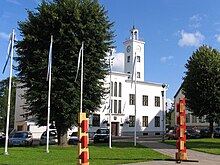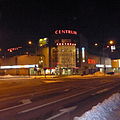Viljandi
| Viljandi | |||
|
|||
| State : |
|
||
| Circle : |
|
||
| Founded : | 1283 | ||
| Coordinates : | 58 ° 22 ′ N , 25 ° 36 ′ E | ||
| Height : | 83 m | ||
| Area : | 14.62 km² | ||
| Residents : | 17,868 (2012) | ||
| Population density : | 1,222 inhabitants per km² | ||
| Time zone : | EET (UTC + 2) | ||
| Telephone code : | (+372) 043 | ||
| Mayor : | Ando Kiviberg | ||
| Postal address : | Linnu 2 71020 Viljandi |
||
| Website : | |||

|
|||
Viljandi (German: Fellin ) is a Hanseatic city in Estonia and the capital of Viljandi County in the south of the country. With almost 18,000 inhabitants, it is the sixth largest city in Estonia.
The distances to other cities in Estonia are: Tallinn 161 km, Tartu 81 km, Pärnu 97 km.
history
The oldest settlement finds on Lake Viljandi go back to the fifth millennium BC. A castle was built by the Estonians in the Viking Age at the latest . The first written mention was made in 1154 by the geographer Al-Idrisi .
In the 12th century, the first permanent settlement around the fortress Viljandi began, which also became the economic center of the later Sakala district .
After the struggle for freedom in the early 13th century, Viljandi was conquered by the German Brotherhood of the Sword . In 1224, instead of the wooden fortifications, construction began on a mighty order castle , which was at times the largest in the Baltic region . It was continuously expanded and modernized in the following 200 years.
In 1283 Fellin received city rights from the master of the order Wilhelm von Endorpe (Wilhelm or Willikin von Endorpe fell on March 26, 1287 near Riga in the battle against the Semgallians ). At the beginning of the 14th century Fellin became a member of the Hanseatic League and thus an important point on the trade route to and from Russia. In 1346 the city was mentioned as a Hanseatic city in documents from the Hanseatic League. In 1365 the peace treaty between Denmark and the Hanseatic League was signed in Fellin.
During the Livonian War in 1560 , the town and the castle were partially destroyed. During the Polish-Russian War at the beginning of the 17th century, the facility was largely destroyed. Today only the castle mountains with partially intact walls are evidence of the splendor of that time.
During the Swedish rule in the 17th century, Fellin's town charter was revoked. This situation lasted until 1783, when a reform made Catherine the Second Fellin the capital of Fellin County in Livonia . With the growing economic and political influence, the population of Viljandi increased again. To this day, Viljandi is a district capital and an important center in southern Estonia with various cultural events.
politics
City administration
After the elections on October 15, 2017, the Viljandis City Council consists of 27 members. They are distributed among the individual parties and groups as follows (column +/−: difference to the previous election in October 2013):
| Political party | Mandates | +/- |
|---|---|---|
| Social Democratic Party | 9 | + 1 |
| Estonian Reform Party | 8th | ± 0 |
| Pro Patria and Res Publica Union | 6th | - 2nd |
| Center Party | 2 | - 1 |
| Conservative Party | 2 | + 2 |
Pro Patria and Res Publica Union, the Estonian Reform Party and the Center Party will form a coalition for the period 2017–2021.
Town twinning
Viljandi maintains city partnerships with
-
 Valmiera in Latvia , since 1960
Valmiera in Latvia , since 1960 -
 Porvoo in Finland , since 1961
Porvoo in Finland , since 1961 -
 Ahrensburg in Schleswig-Holstein , Germany , since 1989
Ahrensburg in Schleswig-Holstein , Germany , since 1989 -
 Härnösand in Sweden, since 1990
Härnösand in Sweden, since 1990 -
 Eslöv in Sweden since 1991
Eslöv in Sweden since 1991 -
 Frostburg in Maryland , USA , since 2000
Frostburg in Maryland , USA , since 2000 -
 Kretinga in Lithuania , since 2008
Kretinga in Lithuania , since 2008 -
 Ternopil in Ukraine
Ternopil in Ukraine
-
 Cumberland in Maryland , USA , since 2013
Cumberland in Maryland , USA , since 2013
economy
Alongside Pärnu and Tartu, Viljandi is an important business location in the region . The following companies are based in Viljandi:
- AS Hansa Candle
- AS Vennad-Dahl
- AS VEOLIA KESKKONNATEENUSED
- Benexon OÜ
- BHC AS
- CLEVERON OÜ
- DELUX OÜ
- Dold Puidutööstus AS
- Eesti Energia
- Eesti Gaas
- ESPAK AS
- Esro AS
- Farm Plant Eesti AS
- Foreco Homes AS
- Galvi-Linda AS
- Kinema OÜ
- Kolmeks AS
- Leho Kaubandus OÜ
- Lehola OÜ
- Nice AS
- Parlin AS
- Pleksor OÜ
- Rovex AS
- Sveba-Dahlen Baltic AS
- Sovek AS
- Tere AS Viljandi
- TRAFOX EESTI OÜ
- Trame AS
- OÜ PRINT BEST PRINTING HOUSE
- Viljandi Metall AS
- Viljandi Naftabaas OÜ
- Viljandi Aken ja Uks AS
- WÜRTH AS
Culture, education, sport
Viljandi is the venue of the internationally known, annual “ Viljandi Folk Music Festival ”.
The Ugala Theater in Viljandi has existed since 1920. There is also a puppet theater for children, a cinema, a bowling alley, a sports school with a rowing club, a music school and a hobby school for leisure activities.
The University of Tartu has a higher education institution in Viljandi with the Viljandi Cultural Academy of the University of Tartu , and the private Estonian Entrepreneurship University of Applied Sciences has a branch.
The Tulevik Viljandi club plays in the second highest league, the highest Estonian football league. The club plays its home games at the Viljandi Linnastaadion .
traffic
There is a train connection from Viljandi to Tallinn . Otherwise you can reach all cities and towns in Estonia from the bus station (Viljandi Bussijaam) . From there, around 50 bus routes leave several times a day. There is also a bus network with 8 lines within the city of Viljandi and its suburbs.
sons and daughters of the town
- Franz Burchard Dörbeck (1799–1835), Baltic German caricaturist and painter
- Leopold v. Pezold (1832–1907), journalist, teacher and author
- Johann Mathias von Holst (1839–1905), Baltic German architect
- Hans Schmidt (1854–1923), German musician (composer and piano) and poet
- Elisabeth Schiemann (1881–1972), German geneticist and crop plant researcher
- August Osvald Westrèn-Doll (1882–1961), German-Baltic Lutheran theologian and pastor
- Joakim Puhk (1888–1942), entrepreneur and sports official
- August Alle (1890–1952), writer
- Evi Liivak (1924–1996), violinist
- Uno Naissoo (1928–1980), composer and music teacher
- Henn-Kaarel Hellat (1932-2017), writer
- Steen Olaf Welding (1936–2019), philosopher
- Raivo Mändmaa (* 1950), architect
- Sirje Tamul (* 1951), historian
- Mart Laar (* 1960), politician and historian
- Helmen Kütt (* 1961), politician
- Helir-Valdor Seeder (born 1964), politician
- Jaanätte (* 1964), playwright, actor and singer
- Kaido Kreen (* 1965), beach volleyball player
- Meelis Atonen (* 1966), politician
- Urmas Kirs (* 1966), football player
- Annely Peebo (* 1971), opera singer (mezzo-soprano)
- Riina Solman (* 1972), politician
- Argo Arbeiter (* 1973), soccer player
- Mati Pari (* 1974) football player
- Aare Pilv (* 1976), literary scholar and writer
- Sander Post (* 1984), soccer player
- Ragnar Klavan (* 1985), football player
- Triinu Kivilaan (* 1989), former bassist in the band Vanilla Ninja , now solo artist
literature
- O. Bendi, A. Kiisla, L. Märss, U. Roosimaa, K. Vilpart: Viljandi . Published by EESTI RIIKLIK KIRJASTUS, Tallinn 1964.
- Erik Thomson: Fellin * Viljandi as it was: One hundred views . Production: Edmund Hahn, Lüneburg 1986.
- Aare Olander: Viljandi kadunud vaatet . Publisher: Tänapäev 2015, ISBN 978-9949-27-829-9 .
- Heiki Raudla: Viljandi lod is legendary . Viljandi 2015, ISBN 978-9949-38-817-2 .
- Toomas Karjahärm, Kirjastus Argo: Vana Viljandi ehitised ja inimesed . Publisher: Argo 2006, ISBN 978-9949-415-62-5 .
- Eha Roosalu: Viljandi . Publisher: OÜ Prind Best 2013, ISBN 978-9949-33-072-0 .
- Elmo Riig, Ragnar Kond: Viljandi town of creation . Publisher: OÜ Meediatee 2009, ISBN 978-9949-18-467-5 .
- Elmo Riig, Ragnar Kond: Viljandisse to Viljandi . Publisher: OÜ Meediatee 2015, ISBN 978-9949-38-446-4 .
Individual evidence
- ↑ Estonian Statistical Office - Omavalitsusüksuste võrdlus, Rahvaarv (rändega), January 1, 2012, Viljandi linn
- ^ City website , accessed July 5, 2018
- ↑ City website - Koalitsioonileping
- ↑ Archived copy ( memento of the original from August 21, 2012 in the Internet Archive ) Info: The archive link was inserted automatically and has not yet been checked. Please check the original and archive link according to the instructions and then remove this notice.



















